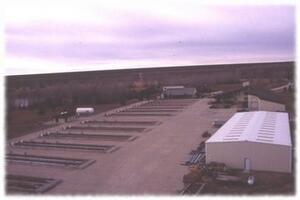Milford Hatchery
The Milford Fish Hatchery is a state-of-the-art facility and one of only a few warm water, "intensive-culture" fish hatcheries in the country. Its objective is the rearing of sport fish for the more than 300,000 Kansas anglers.
The hatchery is one of four department hatcheries in the state. The older facilities at Pratt, Meade, and Farlington use an "extensive" system of fish culture in which earthen ponds are used for hatching and rearing. The Milford Fish Hatchery uses an "intensive" system in which eggs are hatched in small containers, and fish are grown in fiberglass tanks and concrete raceways. The Milford Hatchery also has six one-acre plastic lined ponds that are used to raise fish. Some advantages are that more fish can be raised in less water and the health of the fish can be monitored daily.
Construction of the hatchery was completed in January, 1985, at a total cost of $4.5 million. The Milford Hatchery was financed by money from fishing license fees. The majority of the funding was provided by a $3.00 hatchery fee added to the cost of a regular fishing license.
Each of the 24 concrete raceways holds approximately 18,000 gallons of water and measures 100 feet long, eight feet wide and four feet deep. Depending on the size of fish, a raceway can hold between 35,000 and 150,000 fish weighing 2,000 to 8,000 lbs.
The water source for the hatchery is a combination of well and lake water. During the winter, the water is a constant 58º F since it is taken from wells. The three wells have a combined pumping capacity of 2,500 gallons per minute. Water is taken from the outlet lake south of the. hatchery when the water temperature in the lake has stabilized at or above 60-70ºF.
The large brown hoppers, called demand feeders, contain specially-formulated fish food. The catfish learn to hit a rod that releases the food. The hatchery also uses automatic solar and belt feeders to dispense formulated feed to other fish species.
Each raceway has its own recirculation system in which about one-third of the water is recycled. The water in the raceway is completely exchanged every hour in the summer. Additional oxygen is added to the reaceqays with liquid oxygen by injection into white chambers at the head of each raceway.
The partitions you may see in the raceways do not extend to the bottom, so fish can freely travel up and down the length of the raceway. These baffles help to create a higher water velocity near the bottom to sweep it clean of debris.
All incoming water is aerated by the red towers at the south side of the raceways. Each tower contains a series of aluminum baffles over which water cascades. This allows for oxygen to be added before water is delivered to the raceways.
The large hatchery building holds fish incubation and start tank equipment, electrical monitoring and control equipment, water filtering equipment, a lab, offices, and a shop area.
The mechanical room houses three large sand filters that clean the water used inside for hatching and growing fry. Milford egg hatching
The incubation room consists of four hatching racks, a spawn area, and 16 large catch tanks. Hatching of walleye eggs normally begins in late March and finishes by early May. Eggs are stripped from the females and fertilized in a pan with milt (sperm) taken from the male. The fertilized eggs are then placed in a special plexiglass hatching jar. Water is constantly circulated through the jar to provide oxygen to the eggs. In approximately 10 days, the eggs hatch and the fry, which swim to the top, are swept into catch tanks. When the fry are three to four days old, most are stocked in lakes and reservoirs.
Each hatching jar can hold approximately 300,000 eggs. The maximum capacity for the incubation room is 120 million eggs.
Fish received at the hatchery as fry or fingerlings must be trained to eat pelleted food. When the fish arrive, they are placed in the fiberglass start tanks. Automatic feeder are used to introduce feed every 10-20 minutes around the clock. When the fish are about three inches long and accepted the formulated feed, they are transferred to the raceways.
Milford produces millions of fry each year. Most fry are walleye, sauger and saugeye palmetto bass and striped bass. In addtion to fry, pomestic striped bass brood fish from 15 - 35 lbs. are maintained. Channel catfish (10"), blue catfish (10"), palmetto bass (9"), walleye (8-9"), largemouth bass (6 -8"), paddlefish (12"), and hybrid sunfish (>5") are produced in tanks and raceways. Three-inch fingerlings of walleye, sauger, saugeye and channel catfish are produced annually each year in the plastic lined ponds.
The walleye occur mainly in large lakes. It was found in Kansas as early as 1865 but soon disappeared. It was successfully reintroduced about 1960. Milford produces about 55 – 65 million walleye fry a year.
The blue catfish is a large cousin of the channel catfish. It inhabits large rivers in eastern Kansas and can weigh more than 80 pounds. Milford produces about 20,000 blue cat intermediates each year.
Channel catfish inhabit all large streams in Kansas, as well as most lakes and ponds They do very well in turbid lakes and ponds, and are one of the most popular fish in Kansas. Milford produces over 500,000 channel catfish of all sizes each year.










